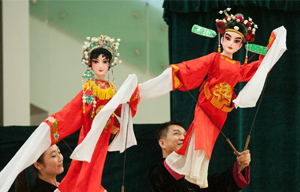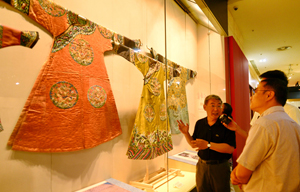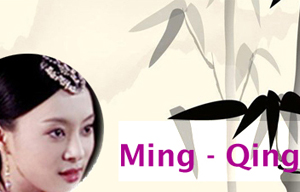New tools preserve ancient treasures
2013-06-17 08:01:28
Being an archaeologist can be boring. Hours of digging square holes in the ground and filling out paperwork, right? That may have been true in the past, but archaeology is more than just about the past, it helps us understand the future. And today's practitioners, with computers and state-of-the-art cameras, would not consider their work boring. "Heritage is not always immortal, it can vanish, but information lasts forever," said Professor Lu Dongming at Zhejiang University. "Excavating and preserving relics is no longer the sole purpose of archaeological digs. All information should be recorded during the process. In fact, digital documentation is as important as preservation," said Lu, who specializes in applying computer technology to archaeological studies.
Intangible heritage provides strength
2013-06-17 10:11:02
Intangible heritage is impalpable like the air, light and nimble like music, and furtive like a dance movement. Yet there is nothing stronger in bringing us together as a single community.
Master strokes
2013-06-16 07:39:41
 Among the world's writing and painting instruments, the writing brush is unique to China. As far back as the Warring States Period (475-221 BC), brushes were widely used for writing and painting. As the world is increasingly dominated by computer fonts and rapid-fire social networks, the craftsmanship of brushmaking is dying out. Fuxinghe in Qufu is a time-honored brand famous for handmade writing brushes. It was recently been listed among Shandong province's intangible cultural heritages. Gong Guizhi, the fifth generation sustainer of the brand, preserves the tradition and is determined to pass down the art.
Among the world's writing and painting instruments, the writing brush is unique to China. As far back as the Warring States Period (475-221 BC), brushes were widely used for writing and painting. As the world is increasingly dominated by computer fonts and rapid-fire social networks, the craftsmanship of brushmaking is dying out. Fuxinghe in Qufu is a time-honored brand famous for handmade writing brushes. It was recently been listed among Shandong province's intangible cultural heritages. Gong Guizhi, the fifth generation sustainer of the brand, preserves the tradition and is determined to pass down the art.
Save the word
2013-06-12 08:01:02
Children in Shanghai will be expected to learn the local dialect in kindergarten, as the city's education authorities plan to enhance folk culture education among the youth.
Cornucopia of culture
2013-06-10 08:18:26
 A female participant in the event kisses the mask of an actor at a restaurant in Kuanzhai Xiangzi.
A female participant in the event kisses the mask of an actor at a restaurant in Kuanzhai Xiangzi.
A voice that brings the past into the present
2013-06-11 08:30:15
"The bank is bumpy, watch your step!" says an old woman on a donkey's back.
Lingnan puppet show held in Guangzhou
2013-06-09 09:48:44
 Performers operate puppets during a Lingnan puppet show held by the Guangdong Provincial Puppet Art Theater at the Guangzhou Library to mark the 8th national Cultural Heritage Day.
Performers operate puppets during a Lingnan puppet show held by the Guangdong Provincial Puppet Art Theater at the Guangzhou Library to mark the 8th national Cultural Heritage Day.
The culture of Chinese small living goods
2013-06-07 15:07:13
 China's traditional arts have made one of the greatest artistic and cultural contributions to the nation's rich heritage and to mankind. This can be seen even from small day-to-day supplies.
China's traditional arts have made one of the greatest artistic and cultural contributions to the nation's rich heritage and to mankind. This can be seen even from small day-to-day supplies.
New dragon boat launched at Shangjiao village in Guangzhou
2013-06-07 14:07:02
 Villagers have a trial run of their new dragon boat during a launching ceremony at the Chenhanhui Shipyard at Shangjiao village in Guangzhou, capital of South China's Guangdong province, June 6, 2013.
Villagers have a trial run of their new dragon boat during a launching ceremony at the Chenhanhui Shipyard at Shangjiao village in Guangzhou, capital of South China's Guangdong province, June 6, 2013.
Garment from Ming and Qing dynasties on display
2013-06-06 17:26:38
 The exhibition, which presents about 200 garments in Shandong's provincial capital Jinan, features clothes worn by emperors, nobles and ordinary people.
The exhibition, which presents about 200 garments in Shandong's provincial capital Jinan, features clothes worn by emperors, nobles and ordinary people.
Ming - Qing Dynasty style
2013-06-06 16:06:29
 Garments from Ming and Qing dynasties are on display.The exhibition, which presents about 200 garments in Shandong's provincial capital Jinan, features clothes worn by emperors, nobles and ordinary people.
Garments from Ming and Qing dynasties are on display.The exhibition, which presents about 200 garments in Shandong's provincial capital Jinan, features clothes worn by emperors, nobles and ordinary people.
Rehearsal of heaven worship performance held in Beijing
2013-02-06 10:51:20
 Performers dressed in costumes of the Qing Dynasty (1644-1911) act during a rehearsal of a performance presenting the ancient royal ritual to worship heaven at the Temple of Heaven in Beijing.
Performers dressed in costumes of the Qing Dynasty (1644-1911) act during a rehearsal of a performance presenting the ancient royal ritual to worship heaven at the Temple of Heaven in Beijing.